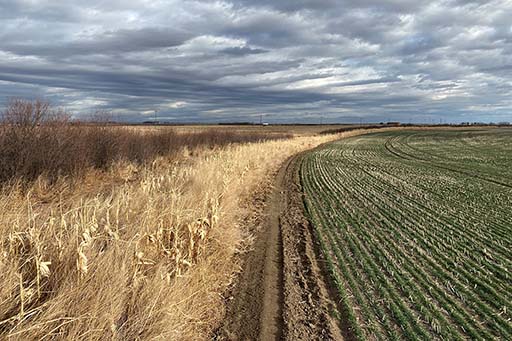Make the most out of your marginal lands!
Whether it's the corner of a pivot circle, a low spot in your field, or a saline patch - marginal land is a blunder for your field. These unproductive patches of land can impede yields and make harvest difficult.
There's not much that can be done to move marginal lands out of the way. Fortunately, they may not be as unproductive as we think!
Ideally, fields would be spread across the prairies, stitched together like a beautiful patchwork quilt. Unfortunately, reality isn't so kind. Our fields are riddled with patches of marginal land - sometimes there are entire fields that aren't productive for agriculture.
In arable land, one of the biggest offenders are saline deposits. While they usually don't grow, they are a persistent problem. Taking years and years to develop, once they're there they can be almost impossible to remedy.
However, just because the odds are against you doesn't mean the land should be untouched!
Thankfully, by putting work into your marginal lands you might be helping the rest of your field.
"It's important to do something in marginal lands," says Farming Smarter's Field Tested Manager Lewis Baarda. "There can actually be a benefit to nearby fields from having this.

A salt tolerant crop that animals can graze would allow the water levels to drop as it pulled the water out of the soil over the years. Regardless of the marginal land you have, it's important to do something with it.
"Whatever you can establish there, it may provide benefit," said Baarda.
Making the most of marginal lands
"I've seen creative ideas," exclaimed Baarda. Whether it was berries or shelterbelts, the ideas shared one key factor. To establish on marginal land in southern Alberta, you were going to need water.
"We're in an arid, semi-arid environment, so if you're putting a specialty crop or a shelterbelt there, you need to get water there," said Baarda. "It's not a simple matter of planting something in marginal land, it's marginal for a reason. You need to do something to get that value out of it."
With projects like this, it can take years to see the value of your investment. Just ask the Stamp & Haggins families!
The time investment these practices require makes it difficult to research, but it doesn't mean it isn't happening.
"There's entomology, looking into shelterbelts, getting into the economics of behind them. There's research on the knock-on effects of some techniques we'd use to reclaim marginal lands, to create biodiversity there," said Baarda.
"For instance, insect biodiversity ≥ predatory insects mean maybe you spray less," added Baarda.
It's not just research into establishing marginal lands. There's also research looking into how to increase productivity around the marginal land.
"There's research that goes into profit mapping ≥ you'd go into a field, looking for where you were productive and where you were not. Every acre, square by square, even if it's in the middle of a field."
With advancements in precision agriculture, one could turn off the seeder and fertilizer as you pass over marginal land with the help of technology.
"Maybe the benefit is the inputs you don't put into land that's not going to produce," added Baarda.
